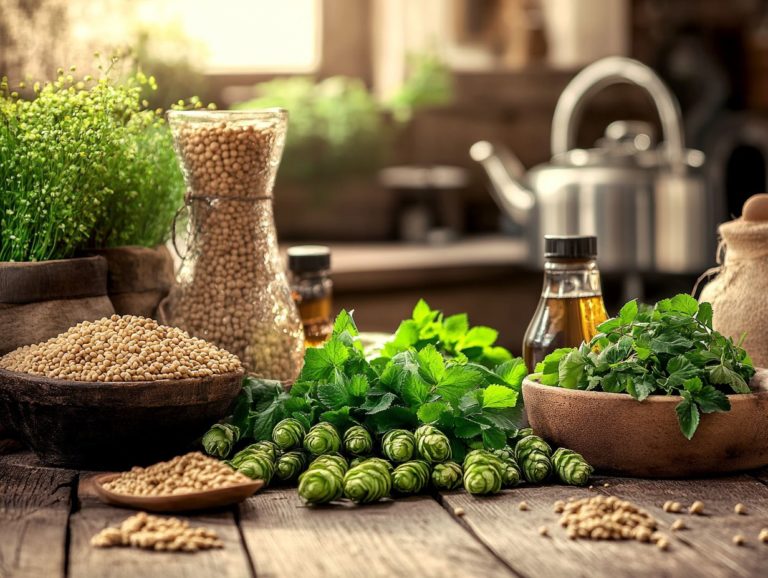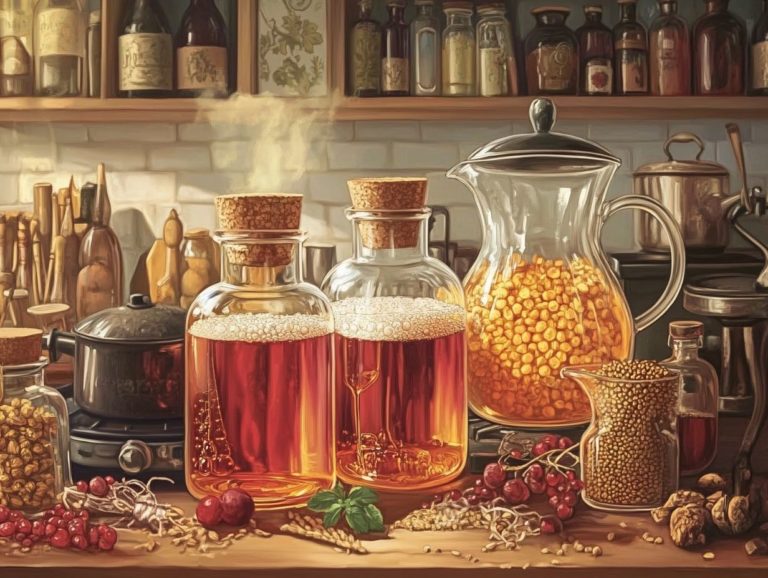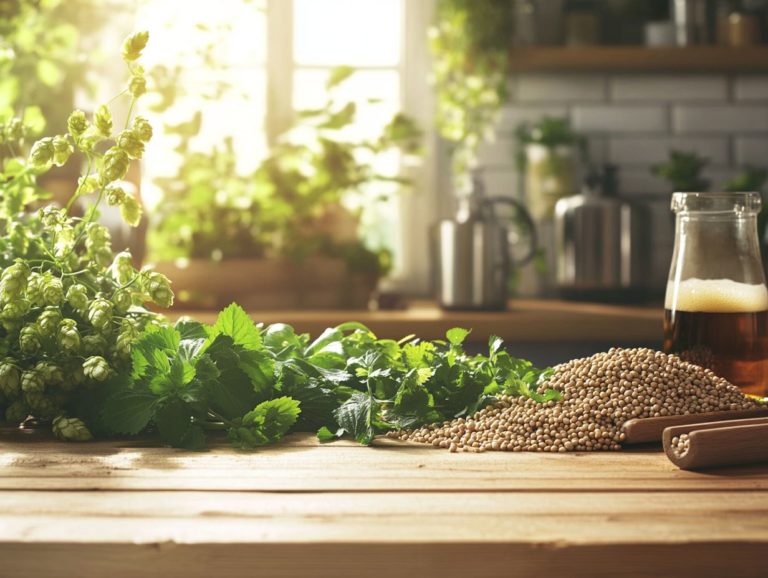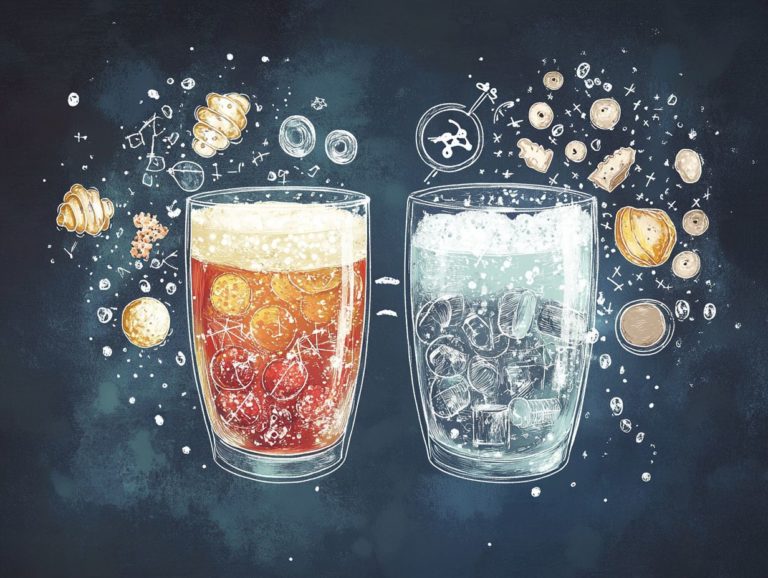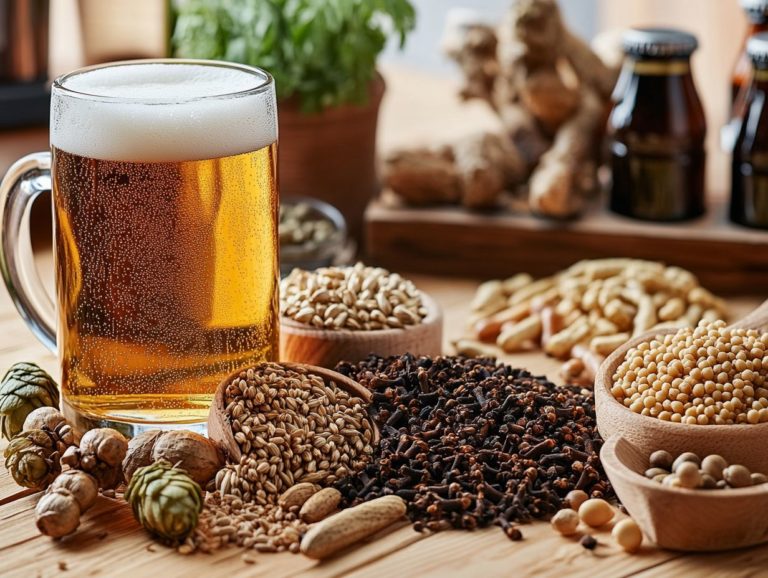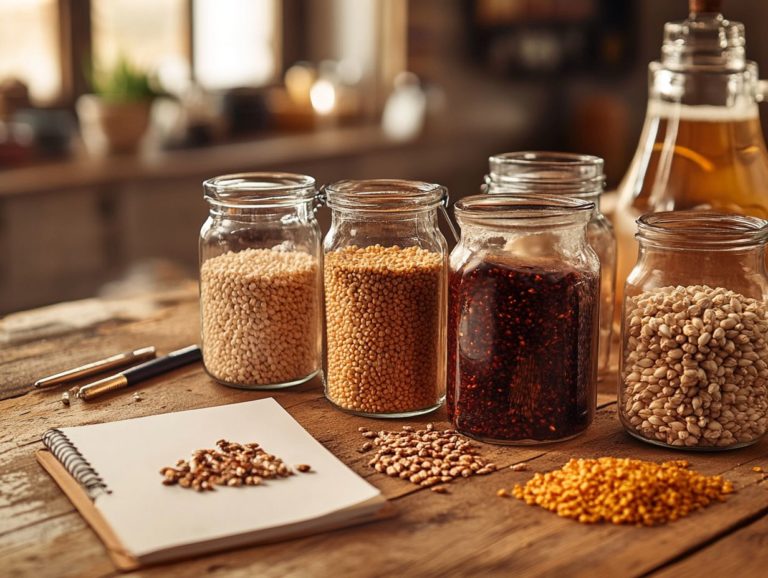Flavoring Your Beer: Tips for Using Additives
Crafting beer is truly an art form, and delving into beer brewing and flavoring beer reveals a realm of creative possibilities just waiting for you to explore.
Whether you re a seasoned brewer or a curious enthusiast, experimenting with various brewing additives can elevate your beer to extraordinary heights. From vibrant fruits and aromatic spices to unique sweeteners, each ingredient contributes its own distinct character and depth to your brew.
Get ready to explore the exciting world of beer flavoring! This guide will help you discover the types of flavorings available, how to select the right ones for your vision, effective techniques for incorporating them, and some enticing flavor combinations to spark inspiration for your next masterpiece in home beer making.
Prepare to transform your beer experience into something exceptional!
Contents
Key Takeaways:
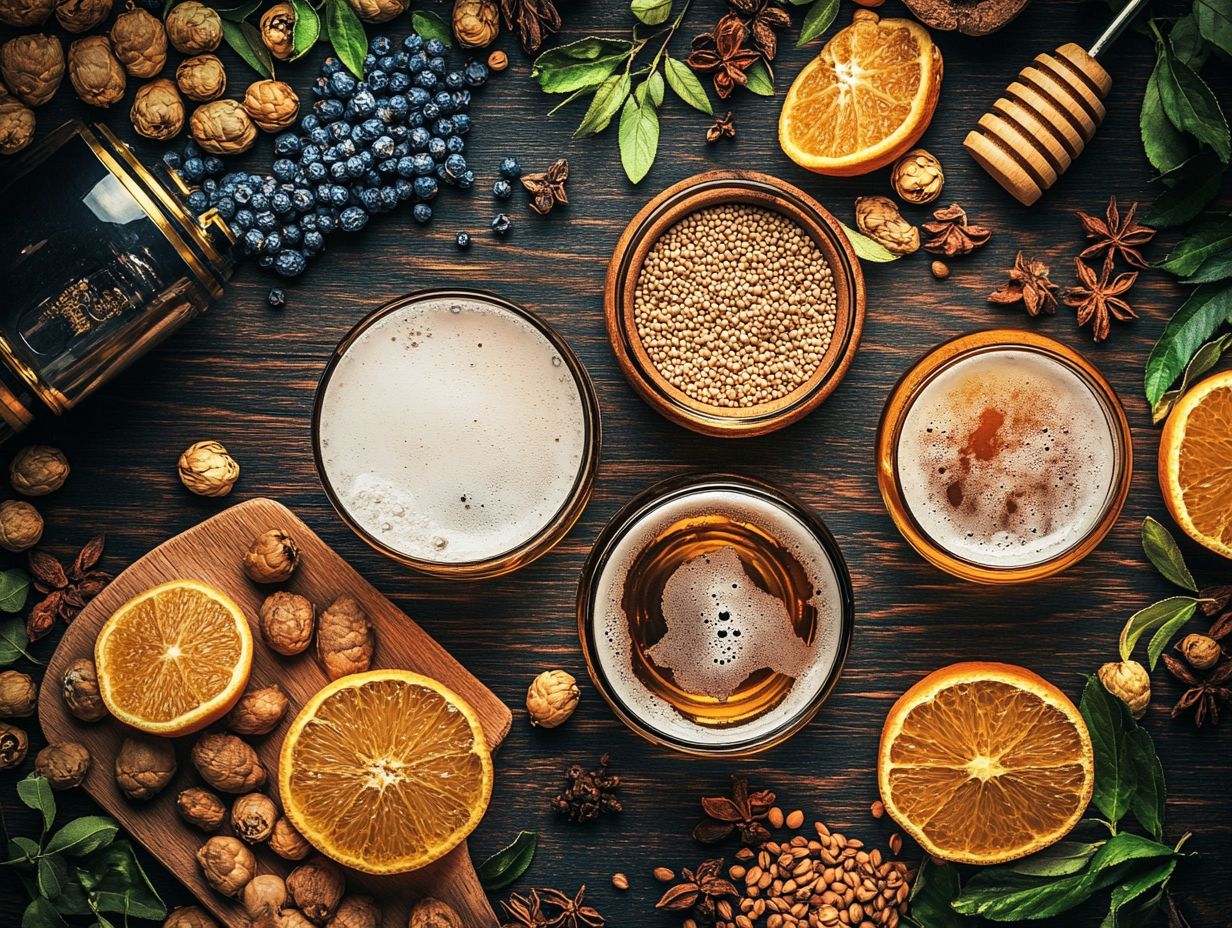
- Experiment with different types of additives to add unique flavor profiles to your beer.
- Consider the style of beer, complementary flavors, and brewing process when choosing brewing additives.
- Add flavor during boiling, fermentation, or bottling/kegging to achieve different levels of intensity.
Why Flavor Your Beer?
Flavoring your beer is a vital part of the brewing process that elevates your overall drinking experience. By introducing unique flavors, you can craft distinctive flavor profiles that appeal to a variety of palates and preferences.
From fruity aromas to savory spices, the art of flavoring beer opens up a realm of creativity and experimentation. It s essential to grasp the significance of flavor balance. This balance plays a key role in determining the quality and clarity of your final product.
Whether you re a seasoned homebrewer or just embarking on your home beer making journey, looking into the world of beer flavoring promises exciting discoveries and innovative homebrewing techniques.
What Are the Different Types of Additives for Beer Flavoring?
When you’re flavoring beer, a range of brewing additives can be employed to elevate both taste and aroma, resulting in a more enriching beer experience. These additives can vary from natural ingredients like fruits and vegetables to sophisticated flavor concentrates, which are specially formulated products designed to enhance flavor, and agents, each capable of crafting an array of distinctive flavor profiles.
Gaining a solid understanding of the various flavoring agents and their effects on taste is vital for homebrewers striving to perfect their homebrewing techniques. Each additive can significantly influence the flavor balance, ultimately impacting the beer clarity and quality of your brew.
1. Fruits and Vegetables
Incorporating fruits and vegetables into your beer brewing process can significantly enhance the flavor profile, adding a unique twist to your home brewing adventures. Fresh fruits like citrus, berries, or stone fruits can impart vibrant aromas and refreshing tastes. Meanwhile, vegetables such as carrots or peppers introduce earthy notes and complexity to your brews.
Be sure to consider water treatment in your brewing process, as it can influence the flavor extraction from these ingredients. The secret to successfully using these ingredients lies in their preparation and timing, ensuring that their natural flavors are preserved and seamlessly integrated into your brewing recipes.
By experimenting with different combinations and incorporating the appropriate yeast nutrient, you can unlock exciting and innovative flavor experiences. For example, a zesty lemon or grapefruit can brighten a pale ale, while luscious raspberries offer a tart balance that complements stouts beautifully.
In terms of vegetables, jalape os can add a surprising kick to a lager, intriguing your palate with unexpected spice. To maximize flavor infusion, it s crucial to add these ingredients at the right stage of the brewing process usually during fermentation for fruits and at the boil for certain vegetables.
Popular fruit-flavored beers, such as IPAs with mango or wheat beers featuring cherries, demonstrate how these additions can elevate the overall drinking experience. They create layers of taste that resonate with discerning craft beer enthusiasts. Using clarifying agents like Irish Moss, Gelatin, or Isinglass can help maintain your beer’s clarity after adding these flavorful ingredients.
Don’t miss out on the chance to elevate your brewing skills! Start your flavor experiments now, and discover a new world of brewing possibilities!
2. Spices and Herbs
Spices and herbs are your secret weapons in the art of beer brewing, enabling you to craft complex and intriguing flavors that elevate your creations. Commonly used spices like coriander, cinnamon, and cloves infuse warmth and depth, while fresh herbs such as mint and basil introduce a refreshing twist.
Timing is everything when it comes to adding these ingredients during the brewing process, as it directly impacts the final flavor balance and clarity of your beer. By understanding how these elements interact with brewing yeast (the process where yeast turns sugars into alcohol) and other additives, you unlock a treasure trove of innovative and delicious brewing possibilities.
Also, consider secondary fermentation for spices and herbs to achieve a more nuanced flavor integration. For example, incorporating spices during the boiling stage can yield more pronounced flavors, while adding them during fermentation allows for a subtler aromatic experience.
It s wise to start with small quantities; just a pinch of nutmeg or a few sprigs of thyme can enhance your brew without overpowering it. Striking that delicate balance between the added flavors and the natural beer profile is crucial, as strong spices can easily take center stage if not carefully moderated.
By experimenting with different combinations and timings, you can uncover unique profiles that preserve the integrity of the beer while introducing delightful complexity.
3. Sweeteners
Sweeteners are essential in the beer flavoring process, expertly balancing bitterness and enhancing the overall taste of your brew. Whether you choose natural sweeteners like honey or maple syrup, or refined options such as brown sugar, these additions can infuse depth and sweetness into various beer styles.
The sweetener you select can dramatically influence the final flavor profile. It s vital for you to experiment with different options to discover the perfect combination for your unique recipes. Understanding how sweeteners interact with yeast during fermentation is crucial for crafting the perfect brew!
Take honey, for example. It not only contributes its distinct floral notes but can also elevate the alcohol content when you incorporate it into a mead. Conversely, brown sugar brings a rich caramel flavor, often found in darker ales like porters and stouts, where it beautifully complements the roasted malt profiles.
When incorporating sweeteners, timing is everything; adding them at different stages of the brewing process can yield varying results. Don’t wait! Taste frequently and adjust amounts gradually to ensure a well-balanced beer that showcases the sweetener s contribution in the most delightful way.
Using Burton Water Salts or other water treatments can enhance the extraction of sweetener flavors during the brewing process.
4. Other Flavorings
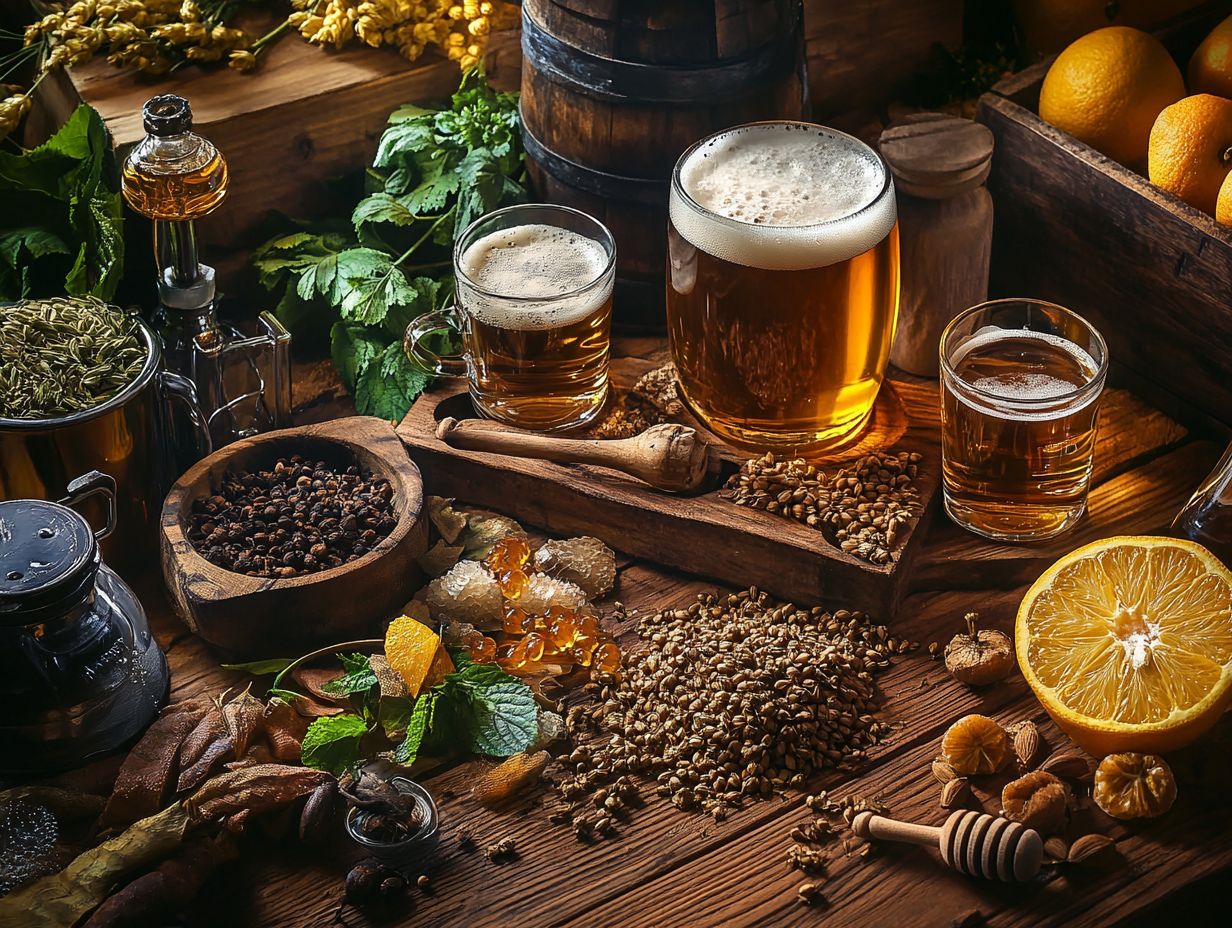
In addition to fruits, vegetables, spices, and sweeteners, you ll find that other flavorings, such as liquid flavoring and flavor concentrates, can significantly elevate the taste of your homebrew. These flavoring agents provide a convenient avenue for you to introduce bold and diverse flavors without the hassle of extensive preparation.
Consider using Alcohol Flavoring Essence or products from One on One Flavors for precise flavor control. Liquid flavorings, like bourbon vanilla or coffee extracts, can impart rich undertones. At the same time, flavor concentrates offer you precise control over the flavor profile. It s crucial to understand how to effectively utilize these products while preserving the integrity of your brewing process to achieve flavorful and balanced beers.
Don’t forget to include brewing tips from experts like John Palmer and David Ackley to enhance your brewing practices. You might also want to explore herbal infusions, such as chamomile or thyme, which can add unique aromatic qualities to your brew.
As you incorporate these flavorings, consider the timing of their addition. For example, adding spices early in the brewing process allows for a fuller extraction of their flavors, whereas some fruit extracts might offer a more pronounced taste if introduced during fermentation. Adjusting the water used in brewing, such as Calcium Carbonate or Gypsum levels, can also enhance the flavor extraction from these herbal infusions.
Don t shy away from experimenting with combinations, as this can lead to delightful surprises and custom flavor profiles. By carefully selecting complementary flavorings that align with your beer’s base style, you can elevate your creations, resulting in beers that not only taste exceptional but also weave a narrative through their intricate layers of flavor.
Why not embark on a brewing adventure with a Bourbon Vanilla Imperial Porter or a daring Clam Chowder Saison? You re sure to surprise your friends!
How to Choose the Right Additives for Your Beer?
Selecting the right additives for your beer is an endeavor that demands careful thought. Consider the desired flavor profile and the nuances of the brewing process. Observing guidelines like the German Beer Purity Law can also help you maintain the purity and quality of your brew.
As a homebrewer, it s essential for you to evaluate your options based on the style of beer you re crafting, the complementary flavors you wish to incorporate, and the overall brewing techniques you intend to implement. This critical assessment paves the way for achieving a balanced and enjoyable final product.
By understanding how various brewing additives interact with one another and with the yeast used during fermentation, you can streamline your decision-making process. With this level of consideration, you re poised to elevate your brewing experience, crafting exceptional home brews that truly stand out. Using additives like Ascorbic Acid can further enhance the flavor profile of your beer.
1. Consider the Style of Beer
When selecting additives for your beer, it s essential to consider the specific style you plan to brew, as each style carries its own unique flavor requirements and characteristics. For instance, a hoppy IPA might shine with the addition of citrus fruits and spices, while a robust stout could be beautifully complemented by chocolate or coffee notes. Refer to brewing water profiles and adjust with Calcium Carbonate or Gypsum to match the specific style requirements.
Understanding how your chosen additives will influence both the flavor profiles and the beer clarity is crucial for achieving a well-rounded final product. By tailoring your brewing recipes to align with the intended beer style, you can create a more harmonious and enjoyable brewing experience.
Take a pale ale, for example; you might want to incorporate floral hops or tropical fruits to amplify its refreshing qualities, while a Belgian-style beer could benefit from the complex richness of orange peel or coriander.
These brewing additives do more than just enhance flavor; they also play a vital role in preserving the beer’s intended aroma and overall experience. By ensuring that the additives work in harmony with the base ingredients, you can craft a balanced beer that not only reflects its style but also meets drinkers’ expectations ultimately leading to a more satisfying and memorable experience.
2. Think About Complementary Flavors
Considering complementary flavors is essential when selecting additives for your beer, as it can significantly elevate your overall tasting experience. By pairing flavors that work in harmony like citrus with floral hops or chocolate with roasted malt you can craft a more complex and delightful flavor profile using various homebrewing techniques.
Understanding the principles of flavor balance gives you the power to avoid clashing tastes and enhance the beer’s overall appeal. Utilize brewing tips to experiment with different combinations, leading to exciting discoveries that can transform your home brewing results.
To identify these complementary flavors, start by breaking down the primary tastes into sweet, sour, bitter, and salty components. This method will help you grasp how certain flavors interact. For example, pairing the sweetness of caramel malts with the bitterness of hops can create a beautifully balanced brew. Fresh herbs like basil or mint can add an unexpected yet delightful twist when combined with a crisp lager.
Exploring classic pairings like ginger and spice or berries and wheat provides a solid foundation for your experimentation. Remember, the secret to successful flavor combinations lies in balance; ensure that no single flavor dominates the palate.
3. Consider the Brewing Process and Additives
When selecting additives for your beer, the brewing process is a critical factor to consider. The timing and method of addition can significantly influence the final flavor. Different stages of brewing such as boiling, fermentation, and conditioning may require specific additives to achieve optimal results.
For example, certain flavoring agents should be added during secondary fermentation for enhanced flavor extraction, while others need to be introduced earlier in the boiling process to maximize their impact. By understanding these brewing techniques alongside proper water treatment and the use of brewing water additives like Gypsum or Magnesium Sulfate, you can make informed decisions about your additive choices.
Your choice of additives can amplify the flavor and aroma of the final product. Imagine the magic of dry hopping during fermentation! It can elevate hoppy aromas and flavors, crafting a vibrant aromatic profile that enhances the overall character of your beer. On the flip side, incorporating spices or fruit during the boil can infuse your brew with deeper, more rounded flavors that harmonize beautifully with the malt backbone.
Utilizing yeast nutrient can also ensure optimal fermentation and flavor development. Careful consideration of when and how to introduce these additives ensures that each ingredient s unique qualities shine through, ultimately leading to a richer and more enjoyable drinking experience.
How to Add Flavor to Your Beer?
You can elevate the flavor of your beer through a variety of methods at different stages of the brewing process, offering you both flexibility and creative freedom in your home beer making journey.
There are several techniques at your disposal to introduce flavors effectively whether it s incorporating flavoring agents during the boiling phase, infusing ingredients during fermentation, or adding them just before bottling or kegging. Each approach influences the final flavor profile.
Understanding these processes gives you the power to achieve your desired results. With the right strategy, flavoring beer can turn everyday brews into truly exceptional creations. Start experimenting today to turn your beers into true masterpieces!
1. During the Boiling Process
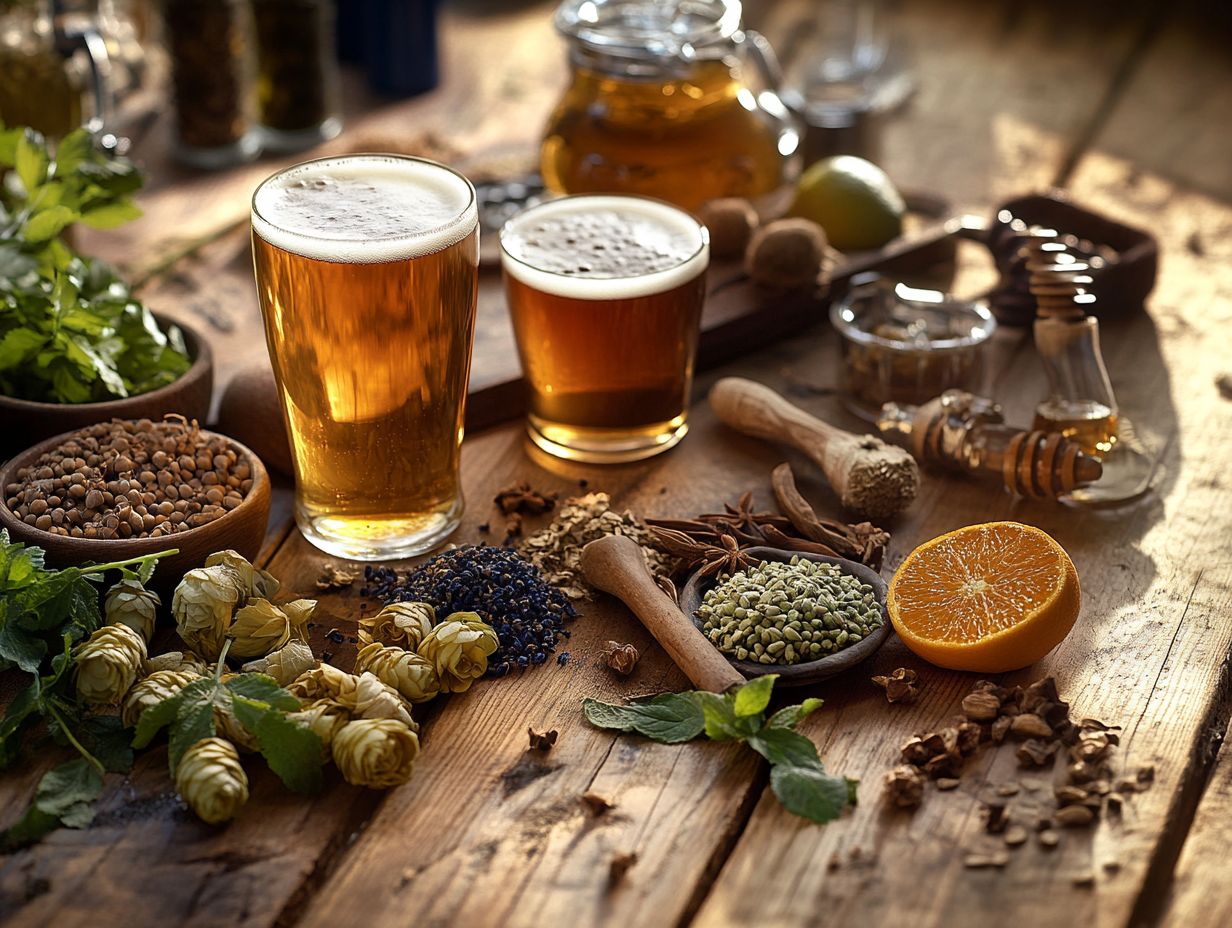
The boiling process is a pivotal moment in your beer brewing journey, where you can introduce flavoring agents to elevate the character and complexity of your brew. In this stage, you’ll add ingredients like hops, spices, or flavor concentrates to the wort, allowing the essential oils and flavors to be extracted beautifully.
Timing is everything here; certain ingredients should be introduced at specific points during the boil to achieve the perfect balance of bitterness and aroma. With some well-chosen brewing tips, you can seamlessly incorporate these flavoring agents, leading to a refined final product.
Understanding the specific roles of various flavoring agents is crucial. For example, when you add hops early in the boil, they contribute primarily to bitterness, while late additions focus on enhancing aroma. To optimize your recipes, calculate precise addition times based on your desired flavor profile and maintain a detailed brewing schedule.
A smart strategy is to keep notes on each batch, adjusting the timing and quantity of ingredients as necessary. This practice allows you to refine your techniques over time, ensuring that each new batch benefits from your past experiences and preferences. Consider using brewing additives such as Irish Moss or Isinglass to improve your beer’s clarity and stability.
2. During Fermentation
Flavoring your beer during fermentation, especially in the secondary stage, is a superb technique for achieving deeper and more nuanced flavor profiles. By adding flavoring agents like fruits, spices, or concentrates at this point, you allow for a smoother integration with the brewing yeast, ultimately enhancing the beer’s overall character. This method also helps minimize the risk of off-flavors that can arise when ingredients are added too early in the brewing process.
As a homebrewer, you have the exciting opportunity to experiment with various additions during fermentation to uncover delightful new flavors.
For instance, adding fresh berries can infuse your beer with vibrant fruit notes, while spices such as coriander or cinnamon can introduce warmth and complexity. Citrus peels like those from oranges or lemons deliver a refreshing zing that brightens the overall taste. Herbal additions, such as mint or basil, can introduce unique aromatic qualities that transform the beer s character. You might also explore using tinctures or alcohol flavoring essence for added depth.
The beauty of secondary fermentation lies in your ability to layer these flavors, crafting an intricate symphony that enhances both aroma and taste, ensuring a truly memorable drinking experience.
3. During Bottling or Kegging
Incorporating flavor during the bottling or kegging stage is a favored technique among homebrewers, enabling you to introduce fresh flavors without subjecting them to additional heat. This method shines when it comes to delicate flavors that might otherwise be lost during boiling, such as subtle herbs or fruits.
By meticulously measuring and adding your flavoring agents right before sealing, you can achieve a vibrant and fresh taste that truly stands out in your final brew. Plus, this technique allows you the freedom to personalize your brewing recipes, giving you the chance to fine-tune flavors to your liking at this crucial final stage. Consider using tools like syringes or graduated cylinders for precise measurements.
While this approach opens the door to incredible customization, it does come with its own set of challenges. One significant consideration is the risk of over-flavoring, which can easily overwhelm the base beer and shift its intended character.
To navigate this potential pitfall, it s essential to begin with small amounts of flavoring and gradually increase until you hit that sweet spot. Using precise measuring tools like syringes or graduated cylinders will help you make consistent and accurate additions. Additionally, following the Reinheitsgebot can ensure you adhere to traditional brewing purity standards.
Engaging in taste tests throughout the process can be invaluable, guiding your adjustments and ensuring you create a balanced and harmonious final product that showcases the added flavors without overshadowing them. You can also draw inspiration from seasoned brewers like John Palmer and David Ackley to enhance your techniques.
What Are Some Popular Flavor Combinations for Beer?
Exploring popular flavor combinations is an exciting journey in the world of beer. Certain pairings can elevate your tasting experience and introduce delightful new characteristics.
Whether you’re enjoying the classic combo of citrus and hops or venturing into the bold territory of chocolate and coffee, the possibilities for crafting distinct flavor profiles are truly limitless.
These combinations not only enhance your enjoyment of the beer but also inspire you, as someone who makes beer at home, to experiment with your brewing recipes. You can push the boundaries of traditional flavors.
By understanding the nuances of each pairing, you can craft remarkable and unforgettable brews that will surely stand out in your home beer-making collection. Get creative and start brewing today!
1. Citrus and Hops
The combination of citrus and hops is a popular flavor combination in the world of beer brewing. It is cherished for its refreshing and vibrant profile.
Imagine the bright notes of oranges, lemons, and grapefruits dancing alongside the bitter and floral nuances of hops. This pairing creates a well-rounded and invigorating beer experience.
For a unique twist, consider experimenting with creative recipes like Bourbon Vanilla Imperial Porter or Clam Chowder Saison.
This delightful pairing shines particularly in pale ales and IPAs, where the hop presence takes center stage. The citrus elevates the overall aroma and taste.
As a homebrewer, you have the opportunity to experiment with various hop varieties and citrus fruits, allowing you to create unique brewing recipes that showcase this enchanting combination.
These lively flavors enhance your drinking experience and evoke a sense of summer freshness that resonates with many beer enthusiasts.
Styles like Session IPAs and American Wheat Ales often highlight this zesty duo. They deliver a satisfying balance of bitterness and citrusy sweetness that is as thirst-quenching as it is flavorful.
If you re eager to incorporate these elements into your brewing process, a key tip is to add citrus zest or juices during the final stages of fermentation. This ensures that those bright notes remain vivid.
By pairing specific citrus types with complementary hop varieties, you can craft a more complex flavor profile that boosts the overall drinkability of your final product.
2. Chocolate and Coffee
The combination of chocolate and coffee creates a rich, indulgent flavor profile that many beer enthusiasts truly appreciate. This pairing is especially popular in darker beers like stouts and porters.
This delightful combination marries the roasted notes of coffee with the sweet, creamy essence of chocolate, resulting in a decadent and satisfying brew.
As a skilled homebrewer, you can experiment with various chocolate malts, coffee beans, or flavor concentrates to achieve the perfect intensity and balance in your brewing recipes.
Thoughtfully selecting the types of chocolate malts and coffee beans can create an extraordinary tasting experience. For example, incorporating a rich dark chocolate malt adds depth, while a smooth, medium-roast coffee bean enhances complexity without overwhelming the brew.
Look to successful examples of this harmonious blend, such as the renowned Founders Breakfast Stout, which elegantly balances robust coffee flavors with hints of chocolate, creating a breakfast-inspired delight.
Another standout is the Left Hand Milk Stout, which beautifully integrates lactose with both cocoa and coffee, resulting in a creamy mouthfeel that beckons beer lovers to return for more.
These techniques not only elevate your flavors but also spark creativity in your brewing, opening up endless possibilities within this delicious spectrum.
3. Berries and Vanilla
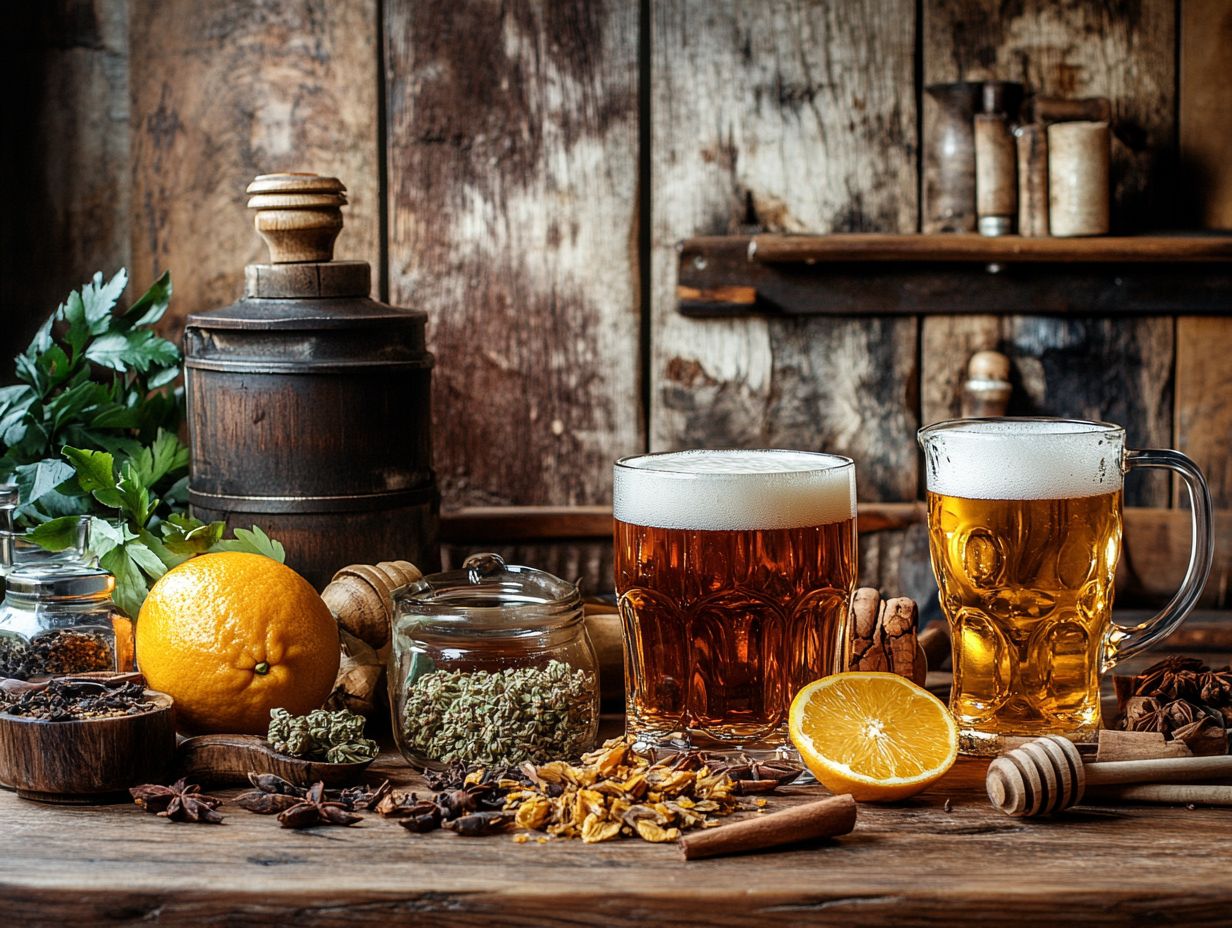
The combination of berries and vanilla creates a delightful and comforting flavor profile. This pairing is often celebrated in fruit beers and cream ales. When you incorporate berries like raspberries, blueberries, or strawberries, you infuse a tart and refreshing essence into your brew.
The addition of vanilla introduces a smooth and creamy backdrop, resulting in a great combination that is simply irresistible.
You ll love this pairing as a homebrewer looking to experiment with fruit-infused creations. The sweetness of vanilla perfectly balances the tartness of the berries, leading to a well-rounded flavor profile. By weaving these flavors into your brewing recipes, you can craft refreshing and satisfying beers that will charm a diverse audience.
To achieve that perfect balance, select berries that complement the specific beer style you’re crafting. Opt for vibrant, ripe varieties that deliver natural sweetness. Freshly picked berries are your best bet for bringing out those bright flavors that shine in fruit beers, while frozen options offer convenience without compromising on quality.
In terms of choosing vanilla, consider using pure vanilla extract or whole vanilla beans. The latter will provide a more robust and nuanced flavor that can elevate your brew. By carefully considering these elements, you’ll enhance the overall taste and improve the beer experience, transforming each sip into a delightful journey.
4. Spices and Pumpkin
Spices and pumpkin come together to create a cozy and seasonal flavor combination that truly shines during the fall months. This combination infuses warmth and richness into a variety of beer styles. The natural sweetness of pumpkin pairs beautifully with spices like cinnamon, nutmeg, and cloves, resulting in a brew that’s not only delightful but also aromatic.
As a homebrewer, you can elevate your craft by incorporating pumpkin puree or roasted pumpkin into your recipes. Blend in those essential spices to create unique seasonal beers that capture the essence of autumn. This harmonious mix enhances the flavor profile and offers a comforting experience for every beer drinker.
To fully embrace this dynamic duo, it’s crucial to select the right beer style think brown ales or stouts that allows the spices to shine without overwhelming the pumpkin s inherent sweetness. Feel free to experiment with various malts and hops, adding depth and complexity to your brew.
If you’re eager to dive into recipe creation, a popular option is the Pumpkin Spice Ale. It involves a generous dose of pumpkin, brown sugar, and a medley of spices added during the boil. Follow this with fermentation using a yeast that embraces warmth. Alternatively, consider crafting a Milk Stout infused with pumpkin and spices for a creamy, dessert-like finish.
And don t forget to share your flavorful creations with friends; after all, sampling these seasonal beers together enhances the joy of autumn gatherings.
Frequently Asked Questions
What are some common additives used for flavoring beer?
Some common additives used for flavoring beer include fruits, herbs, spices, and wood chips. These can add unique flavors and aromas to your beer.
Do different additives affect the flavor of beer differently?
Yes, different additives can significantly impact the flavor of your beer. For example, fruits can add a fruity sweetness, while herbs and spices bring a spicy or herbal note.
How should I add additives to my beer?
The method of adding additives to your beer depends on the specific ingredient and the desired flavor. Some additives, like fruits, may need to be added during the brewing process, while others can be added directly to the fermenter.
Can I use too much or too little of an additive in my beer?
Yes, using too much or too little of an additive can affect the flavor of your beer. It’s important to follow a recipe or experiment with small amounts to find the right balance of flavors.
Are there any additives that should be avoided when flavoring beer?
Some additives, such as artificial flavorings or oils, should be avoided when flavoring beer. These can negatively affect the taste and aroma of the beer.
Don t wait, start experimenting with these additives today!
How can I ensure that the flavors from additives are balanced in my beer?
Unlock the secret to delicious beer by tasting it regularly and tweaking the flavors to perfection!
Taste your beer throughout the brewing process and adjust as needed. Ask experienced brewers for advice or experiment with different combinations of additives to find your ideal balance.

